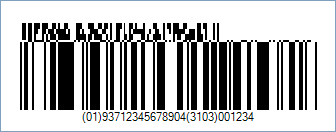

This Symbology is also known as GS1 DataBar Expanded Composite Barcode, GS1 DataBar Expanded CC-A (CCA), GS1 DataBar Expanded CC-B (CCB), GS1 DataBar Expanded Composite A, GS1 DataBar Expanded Composite B, GS1 DataBar Expanded 2D Composite, GS1 DataBar Expanded Composite Component A, GS1 DataBar Expanded Composite Component B
This Barcode Symbology is supported by the following Neodynamic products: In Barcode Composite Symbology, the linear component encodes the item's primary identification while the adjacent 2D Composite Component (abbreviated as CC) encodes supplementary data, such as a batch number and expiration date. The Composite Symbol always includes a linear component so that the primary identification is readable by all scanning technologies. The Composite Symbol always includes a multi-row 2D Composite Component that can be read with linear- and area-CCD scanners, and with linear and rastering laser scanners. The 2D Composite Component is printed above the linear component and both are separated by a separator pattern.
In Barcode Composite Symbology, the linear component encodes the item's primary identification while the adjacent 2D Composite Component (abbreviated as CC) encodes supplementary data, such as a batch number and expiration date. The Composite Symbol always includes a linear component so that the primary identification is readable by all scanning technologies. The Composite Symbol always includes a multi-row 2D Composite Component that can be read with linear- and area-CCD scanners, and with linear and rastering laser scanners. The 2D Composite Component is printed above the linear component and both are separated by a separator pattern.
NOTE: The Primary Data must comply GS1-128 (UCC/EAN-128) data format i.e. application identifiers (AIs) + data fields
Code property = (01)93712345678904(3103)001234|911A2B3C4D5E (Primary Data = (01)93712345678904(3103)001234 and Secondary Data = 911A2B3C4D5E), Symbology property = GS1DataBarExpandedCCA, AddChecksum property = True will produce the following barcode image:

Code property = (01)93712345678904(3103)001234|911A2B3C4D5E (Primary Data = (01)93712345678904(3103)001234 and Secondary Data = 911A2B3C4D5E), Symbology property = GS1DataBarExpandedCCB, AddChecksum property = True will produce the following barcode image:
